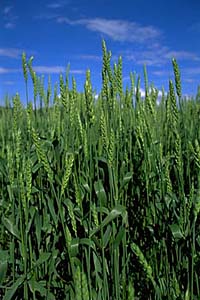|
|

|
| Soil fertility can be interpreted as an equation in which nutrients are lost and added over a period of time, usually a growing season. Maintaining a balance of nutrients for maximum economic yield is the job of soil management. | |||

Nitrogen Nitrogen is a key element in protein formation. Nitrogen is valuable for growth and for proper body functioning. An intake of nitrogen in deficient plants is most noticeable by an increase in the size and greenness of leaves. Some Saskatchewan wheat is graded by protein content. Roots absorb nitrogen mainly in the form of nitrate ions (also some ammonium). Certain bacteria change the nitrogen into the usable form by the processes of ammonification and nitrification. | |||
If we use nitrogen as a model for a fertility balance equation: Losses:
Additions:
Phosphorus Phosphorus is essential for the early maturity of crops and for root growth. Small seedlings, especially, benefit from a good phosphorus supply. Phosphorus is the most immobile of the macronutrient elements. If we placed a pellet of phosphorus fertilizer in the soil we would not expect the phosphorus from the pellet to move more than a cm or so. Since phosphorus is not as soluble or as mobile as nitrogen, it is not as easily leached out of the soil. Since roots literally have to grow into the zones where the fertilizer has been placed, poorly placed fertilizer, too far from the seed, may result in phosphorus deficiency to the seedlings. Phosphorus that is added to soil as soluble fertilizer in the form of the orthophosphate anions H2PO4 - and HPO42- is converted over time to more insoluble and less available forms such as apatite. Most Saskatchewan soils need regular phosphorus additions and phosphorus analysis is part of a normal soil or plant test. The most effective way to apply phosphorus fertilizer is with the seed or seed placed. A rate of 20 to 30 kg/ha of 11-55-0 as P2O5 is usually sufficient to supply the crop. Phosphorus fertilizers give a so called pop-up effect when seeds germinate in cool damp conditions. phosphorus placed close to the germinating seed allows for rapid root growth and seedlings will emerge faster than those with no fertilizer. Potassium Potassium is utilized by a plant in the development of strong stems. This macronutrient also assists the plant in obtaining a higher tolerance to disease and helps to assist the plant in its use of water. Most potassium in plants is found in the above ground portion of cereal and oilseeds, mainly in the straw. Therefore, if crop residues are returned to the soil, a good proportion of the potassium is conserved. In soils, potassium is found as part of the mineral structure of many clay minerals particularly micas. In this form, however, it is locked away from plant roots. The other forms of potassium that are available are part of the K+ cations on the soil exchange complex and in solution. Potassium fertilization is not common in most Saskatchewan soils. Certain sandy soils in the Gray-Black and Gray soil zones have benefited from the addition of Potassium particular when crops such as barley are grown. Most of the potash ore mined in Saskatchewan is exported giving the Province a valuable industry. Sulphur Plants such as canola, mustard, forage legumes and annual legumes (peas, lentils...). produce a large amount of protein in their tissues and seeds. Protein synthesis not only needs nitrogen and phosphorus, but also require large amounts of sulphur. In addition to protein synthesis, sulphur is necessary for essential oils in brassicas and onions and for some enzyme actions and general growth. A number of agricultural practices decrease the levels of this element. Higher moisture levels, which increase leaching, carry the more soluble sulphates salts out of the upper soil zones. Microbial actions to replace these sulphur compounds are normally slow and have decreased even further with minimum tillage practices. Heavier straw and stubble covers lead to upper soil layers being cooler and more moist. Both conditions slow down microorganisms and sulphate formation. Heavier stands (growths) of alfalfa, clover and canola can remove enough sulphur in a growing season to noticeably affect next season's stand, especially if it is of a legume or mustard family. Many soils in the Black and Gray soil zones are deficient in sulphur and a few soils in the Dark Brown and Brown soil zones. The deficiency will spread as we continue to lose large amounts of this nutrient in annual crops and leaching. Which soils in the province will never need sulphur fertilization - the saline soils? Why? |